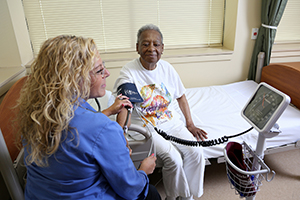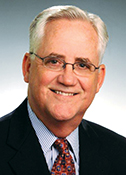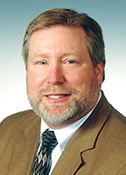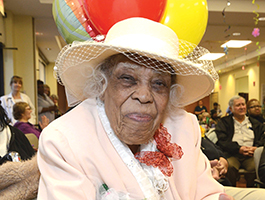By JULIE MINDA
Under health care reform, health care providers must become adept at managing the health of populations of people, and in many cases, under capitated, value-based payment models. And, particularly when these providers assume financial risk for the care of patients, they must become adept at coordinating the care of frail, sick people.
Providers navigating this shift to population health management can learn from the experience of Programs of All-Inclusive Care for the Elderly — many of those programs have been operational for more than a decade; and the programs use a capitated payment structure that is similar to some of the care financing models gaining ground under health care reform, including global payments to accountable care organizations.
Leaders of Trinity Health's senior services division said that system's learnings as the nation's largest PACE provider managing the health of a frail, poor, elderly population in a cost-contained environment may be instructive to providers transitioning to the new payment and risk models. "PACE is basically a geriatric ACO — it operates in almost the same way" as the ACOs being developed under health care reform, explained John Capasso, executive vice president of the continuing care group for Livonia, Mich.-based Trinity Health. Trinity Health leaders believe the population health management approaches and capabilities their PACE teams have honed over the years — including the effective use of interdisciplinary teams, care coordination and care plans — could provide a blueprint for similar work to improve quality and contain costs under other capitated payment models.

Carrie Weiss, a nurse with the LIFE St. Mary Program of All-Inclusive Care for the Elderly in Trevose, Pa., takes the blood pressure of LIFE participant Annie McClease.
And the population that is the focus of PACE — those dually eligible for Medicare and Medicaid — should be of particular concern to all health care providers because the elderly poor often have complex and very costly health care needs, said Bill Healy, Trinity Health vice president of the continuing care division.
Healy and Kelly Hopkins, Trinity Health vice president of PACE and long-term managed care, will lead the Innovation Forum session "PACE: Pioneering Care of the Dual Eligible Population" at the Catholic Health Assembly June 7 to 9 in Washington, D.C.

Healy
Healy said, "The dual-eligible population is growing, and they're going to use a disproportionately higher share of resources than the rest of the population. It is incumbent on us (health care providers) to make sure that we provide value across the board, and a high level of care at a lower cost — and managing that speaks to the whole population health management" aspect that is the cornerstone of Trinity Health's PACE work.
Ahead of their time
PACE is for people aged 55 or older, who are eligible for Medicare and Medicaid and who qualify for nursing home care, but are able to live safely in a location other than a nursing home with the help of PACE support. PACE participants waive their traditional Medicare and Medicaid benefits in exchange for the comprehensive services of a PACE program. PACE providers receive a per-person, per-month capitated payment from Medicare, Medicare Part D and Medicaid, and manage and accept full financial risk for all of the participants' care.

Hopkins
PACE began as a demonstration program in 1971 then expanded on a very limited basis from the late 1980s through 2006, when federal legislation passed that supported broader PACE expansion. There are now 110 PACE programs in 32 states.
Trinity Health's first PACE program began in 1996 in Albany, N.Y.; and the system currently has 11 PACE programs with 15 centers in eight states, most of them located in the same city as a Trinity Health hospital. (The vast majority of these PACE programs began under Catholic Health East management; CHE merged with Trinity Health in 2013.) Trinity Health plans to open several new PACE programs in the next year.
Like all PACE programs, Trinity Health's locations centralize many health and social services at one center. The programs provide transportation to and from the centers and to services located elsewhere. Among the services offered on and off PACE campuses: adult day care that includes nursing, physical, occupational and recreational therapies; meals; nutritional counseling; social work and personal care; home health care; prescription drug access; social services; spiritual services; and medical care.
Life care plan
Hopkins said that interdisciplinary teams have become very adept in the creation and effective use of a life care plan for each PACE participant. The team of clinicians, social service providers, nutritionists, therapists and others — most of whom are located at the PACE center — meet with the participant at the time of enrollment to complete a full assessment of his or her needs. In most cases, the participants have multiple chronic conditions. The team collaborates to develop and update the care plan.
Hopkins said team members meet every morning to discuss clients. This close communication helps head off problems and better ensure PACE participants avoid preventable health crises and related hospitalizations.
Hopkins said Trinity Health's PACE programs have seen improvements over time in quality and participant satisfaction, and they've seen a decrease in hospital readmissions within 30 days of discharge among PACE participants.
PACE operators throughout Trinity Health share their best practices and help one another problem solve. Hopkins noted that executives involved with PACE also collaborate with executives and others at Trinity Health who are developing or running ACOs.

Anna Scott of Camden, N.J., celebrates her 100th birthday at LIFE at Lourdes, a Trinity Health PACE program in Pennsauken, N.J.
Good company
The PACE programs improve participants' quality of life in part by providing opportunities for people who might otherwise be homebound to interact with others and to nurture their spiritual and emotional health, Capasso said. "If you're living at home with family members (and not taking part in PACE), you're probably sitting home alone a lot watching TV."
Marie Murphy, 83, learned of the LIFE St. Mary PACE program in Trevose, Pa., after the death of her husband last year. She's been going to that PACE program's LIFE Center several times a week nearly every week since the fall. She gets help managing her chronic obstructive pulmonary disease, she visits on-site doctors to have health checks, she attends Mass at the center and is part of a group that prays the rosary.
As a self-described "people person," she says her favorite aspect of PACE is the chance to engage with fellow PACE participants at the center. She and her husband had spent much time with their couple friends, but after his death, Murphy found herself alone much of the time, and feeling depressed. Joining PACE "saved my life. I enjoy sitting at different tables at PACE and talking with different people — talking about their lives and laughing about their antics. (Coming to PACE) is something to look forward to.
"I am taking my life back," she said.
Copyright © 2015 by the Catholic Health Association
of the United States
For reprint permission, contact Betty Crosby or call (314) 253-3477.